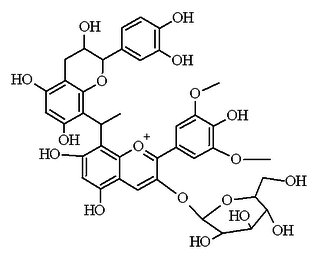
Delphinidin is an anthocyanidin, a primary plant pigment, and also an antioxidant. Delphinidin gives blue hues to flowers in the genera Viola and Delphinium. It also gives the blue-red color of the grape that produces Cabernet Sauvignon, and can be found in cranberries and Concord grapes as well as pomegranates, and bilberries.
Hydroxycinnamic acids (hydroxycinnamates) are a class of aromatic acids or phenylpropanoids having a C6–C3 skeleton. These compounds are hydroxy derivatives of cinnamic acid.

Damascenones are a series of closely related chemical compounds that are components of a variety of essential oils. The damascenones belong to a family of chemicals known as rose ketones, which also includes damascones and ionones. beta-Damascenone is a major contributor to the aroma of roses, despite its very low concentration, and is an important fragrance chemical used in perfumery.

Anthocyanins are water-soluble vacuolar pigments that, depending on their pH, may appear red, purple, blue or black. Food plants rich in anthocyanins include the blueberry, raspberry, black rice, and black soybean, among many others that are red, blue, purple, or black. Some of the colors of autumn leaves are derived from anthocyanins.

The phenolic content in wine refers to the phenolic compounds—natural phenol and polyphenols—in wine, which include a large group of several hundred chemical compounds that affect the taste, color and mouthfeel of wine. These compounds include phenolic acids, stilbenoids, flavonols, dihydroflavonols, anthocyanins, flavanol monomers (catechins) and flavanol polymers (proanthocyanidins). This large group of natural phenols can be broadly separated into two categories, flavonoids and non-flavonoids. Flavonoids include the anthocyanins and tannins which contribute to the color and mouthfeel of the wine. The non-flavonoids include the stilbenoids such as resveratrol and phenolic acids such as benzoic, caffeic and cinnamic acids.

The color of wine is one of the most easily recognizable characteristics of wines. Color is also an element in wine tasting since heavy wines generally have a deeper color. The accessory traditionally used to judge the wine color was the tastevin, a shallow cup allowing one to see the color of the liquid in the dim light of a cellar. The color is an element in the classification of wines.

Chrysanthemin is an anthocyanin. It is the 3-glucoside of cyanidin.

Procyanidin B5 is a B type proanthocyanidin.

Laricitrin is an O-methylated flavonol, a type of flavonoid. It is found in red grape and in Vaccinium uliginosum. It is one of the phenolic compounds present in wine.

The grape reaction product is a phenolic compound explaining the disappearance of caftaric acid from grape must during processing. It is also found in aged red wines. Its enzymatic production by polyphenol oxidase is important in limiting the browning of musts, especially in white wine production. The product can be recreated in model solutions.
Copigmentation is a phenomenon where pigmentation due to anthocyanidins is reinforced by the presence of other colorless flavonoids known as cofactors or “copigments”. This occurs by the formation of a non-covalently-linked complex.

Vitisin A is a natural phenol found in red wines. It is a pyranoanthocyanin.

Wine is a complex mixture of chemical compounds in a hydro-alcoholic solution with a pH around 4.

Malvidin glucoside-ethyl-catechin is a flavanol-anthocyanin adduct. Flavanol-anthocyanin adducts are formed during wine ageing through reactions between anthocyanins and tannins present in grape, with yeast metabolites such as acetaldehyde. Acetaldehyde-induced reactions yield ethyl-linked species such as malvidin glucoside-ethyl-catechin.

Flavanol-anthocyanin adducts are formed during wine ageing through reactions between anthocyanins and tannins present in grape, with yeast metabolites such as acetaldehyde. Acetaldehyde-induced reactions yield ethyl-linked species such as malvidin glucoside-ethyl-catechin.

Oxovitisin A is an oxovitisin, a type of pyranoanthocyanin with a pyranone (2-pyrone) component. It is found in aged Port wines. It does not contain an oxonium ion component, as anthocyanins do. Therefore it does not have an absorption maximum at 520 nm. Oxovitisins are stable yellowish pigments with similar unique spectral features, displaying only a pronounced broad band around 370 nm in the UV−vis spectrum. It is an oxidative derivative of carboxypyranomalvidin-3-glucoside.

Oxovitisins are a type of pyranoanthocyanin with a pyranone (2-pyrone) component found in aged Port wines. They do not contain an oxonium ion component, as anthocyanins do. Therefore they do not have an absorption maximum at 520 nm. Oxovitisins are stable yellowish pigments with similar unique spectral features, displaying only a pronounced broad band around 370 nm in the UV−vis spectrum.

Ideain, the cyanidin 3-O-galactoside, is an anthocyanin, a type of plant pigment.















